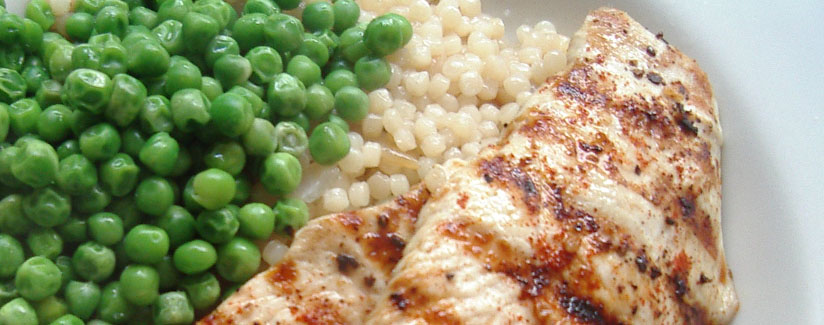
Chicken: Keeping it healthy
12/21/2011
Updated 9/11/2015
Looking for a heart-healthy protein to incorporate into your diet? Brenda Roche Wolford, MS, RD, one of our food system experts, gives some practical advice for choosing the healthiest, safest and best chicken for your family’s needs.
What is the healthiest chicken to purchase at the grocery store?
Roche Wolford:
Out of all the chicken options at the grocery story, the healthiest option is fresh chicken breast. The white meat (chicken breast) has slightly less cholesterol than the dark meat (legs and wings). It is definitely lower in saturated fats. In general, poultry is a heart-healthy protein. Usually, the less processed it is, the better. Be sure to remove the skin of the chicken, and you will have a really great source of lean protein.
Labeling is so confusing. What should I look for? What about natural, organic, farm-raised, free-range, antibiotic-free, etc.? Is one healthier than the other?
Roche Wolford:
There are a lot of labels out there these days, so it’s important for consumers to understand what the labels mean. Labels like organic, natural, free-range and antibiotic-free are more of a personal preference for consumers. Some of these terms are regulated by the USDA, and others are not. There might be a difference in the taste or quality that the consumer might prefer with certain labels. However, just because it has one of those labels does not mean it is healthier.
For more information on label definitions, please visit our post on food labels here.
Do you have any tips to help us read labels?
Roche Wolford:
A food company can make quite a few claims about their product on the labels. However, the consumer should not let label claims get in the way of their purchase. I know all the terms can be confusing, but what’s most important to know is that chicken is a healthy meat option.
- Look for chicken without the skin. Or if you purchase it with the skin, remove the skin because it has more cholesterol and saturated fat. White meat in chicken is heart-healthy and is generally a good choice for a lean protein.
- If you are purchasing chicken that has been processed in some way, look at the nutrition facts panel. For instance, if you are buying ground poultry instead of ground beef because you think it is a healthier option, double check the label. Ground poultry could have as much fat as ground beef, possibly more, because the processor might include the dark meat and skin when grinding the poultry.
- Again, read the nutrition facts for chicken that has been processed. Processed food may have added salt, so review the sodium levels. It’s very important to look at the nutrition facts panel when buying any food or poultry item that’s been processed.
Are there grades or classifications for poultry products like beef?
Roche Wolford:
Grading is not mandatory for poultry. Inspection is mandatory, but the grading is voluntary. Grading has regulations in terms of the quality of the poultry. It has to do with the appearance in the quality.
What is “plumping?”
Roche Wolford:
Plumping is a process some poultry products receive where the chicken breast may be enhanced or might have added salt, water or flavoring such as teriyaki sauce. Plumping is adding a mixture of solution, and the presence and amount of the solution will be labeled as part of the product name. However, the label may be confusing. Even if the product says 100% all natural, it may have been injected with a solution. The USDA released a final rule which would require clearly labeling raw meats to which solutions have been added. This rule will make companies more clearly disclose whether solution has been added. This ensures that companies are giving consumers this information in as simple a format as possible. Prior to this ruling, companies could put this information wherever they want to on the packaging, but with the new rule, it will become part of the product description. This final rule will go into effect January 1, 2016.

Former USDA labeling rule.

Current USDA labeling rule.
Does sodium content increase with more processing?
Roche Wolford:
In general, yes, sodium usually increases with more processing. Sodium is an ingredient that’s used for preservation, but also for taste and texture and to extend the shelf life. Nowadays, consumers are more aware of the sodium content of the foods they’re eating. Most of the sodium in our diet comes from the processed foods we eat, not from the salt we put on our food at the table. Check the nutrition facts label and compare the sodium content to other labels before buying the product. Choose the product with the least amount of sodium.
“another lunch” by ella is licensed under CC BY 2.0.


























